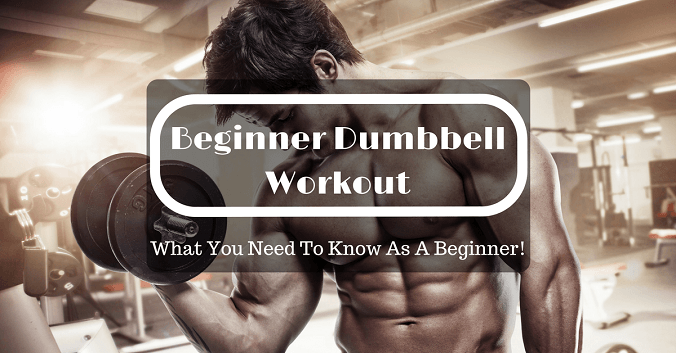You’ve just started going to the gym, and you saw the dumbbell rack and you still have no idea over how it is used. Then don’t fret because this article will help you through your Dumbbell Training needs. You will be amazed on how much training you can do with only a pair of dumbbells in your hands. You can even do them elsewhere – in your house too!
This tutorial will focus on the different Beginner Dumbbell workout routines and we will know which part of the body it affects and also it’s other benefits for you.
More...
Carry that Dumbbell!
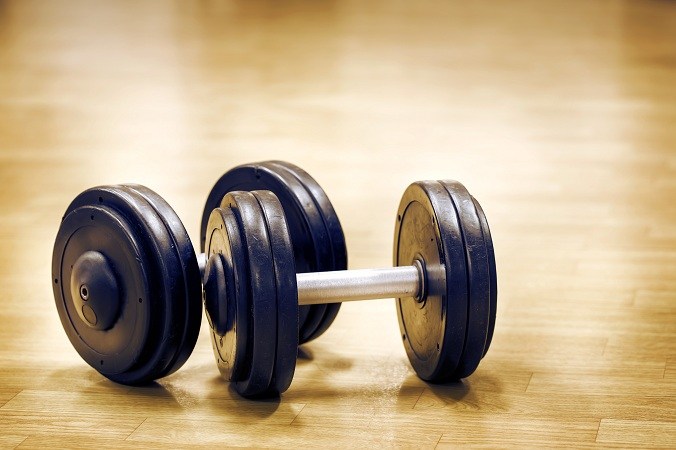
Dumbbells are also known as free-weights. This is because the weight you can add to each dumbbell bar is limitless. You can allocate the weight that you want depending on your strength and how much you have progressed in your workout.
As much as calisthenics can give you some benefits to the body, the Dumbbells can give you a little more than usual. The resistance that it gives is greater than your body weight, thus letting you maximize your workout routine.
The Free-weight Benefits
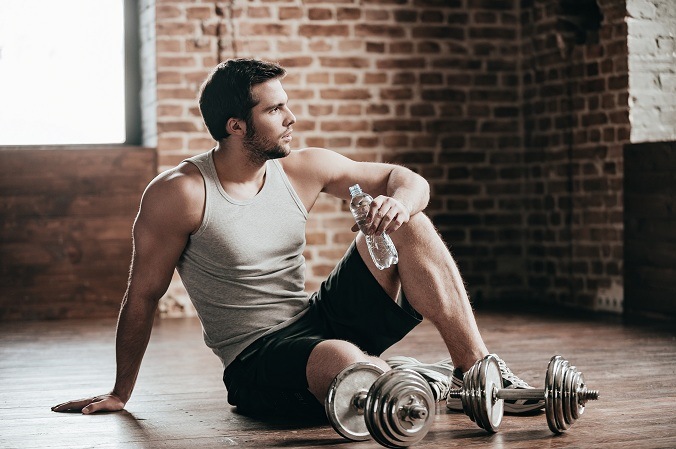
Let’s look at some benefits that dumbbell training can give you:
BOOSTING YOUR SELF-ESTEEM
While other forms of exercise in the gym can help in building your body wider, the dumbbells provide something better. What most people want in their workout is not the getting “wide” part but more of the “lean” body form. While other exercises build your body to become bigger, the dumbbells can give you a tighter body, meaning most of the muscles in your body are bulked together and give you a sexier and confident look.
INCREASE YOUR METABOLIC RATE
With dumbbells, we lift more weight than what we usually do. Thus, the rate
QUICKER RESULTS !
Opposed to cardio training, Dumbbell training burns more.
Most of the training in dumbbell training requires both stamina and upper body strength so your full body is exerted to its limit. What you can burn in one hour with lifting dumbbells (including the different forms) is far greater than just your morning jog or bicycle training cardio.
What Not To Do !!!
#1 - Not For The Injured Person
Do not attempt to use dumbbells if your body is suffering from certain injuries at present. This may cause over-damage to your injury. This is especially hazardous to people with injuries on their upper body (e.g. Shoulder/Arm/chest). You will not be able to do the proper form of Dumbbell exercise when in this condition and it could only strain your muscles the bad way. Try an alternative form of exercise if possible
#2 - Do The Right Form Every Lift!
This is a common mistake especially if you’re just a starter in trying dumbbells. Never forget to put your elbows below your shoulders. If you try to overextend, this can cause damage to the elbow and shoulder joints and muscle tear. These injuries may become permanent depending on the damage so remember to perform the proper exercise when doing so.
#3 - Do not Lock those Elbows
Remember to avoid locking your elbows during the exercises. These causes stress in your join areas which leads to serious injuries. Don’t rush when performing these exercises and always try to study the motions involved so you don’t suffer any elbow injury. Some of these injuries include damages to your rotator cuff. This is a common mistake for beginners so be sure to study the form well before executing it. If a gym trainer is available, try to ask them to demonstrate the full form and remember each step.
#4 - Go at Your Own Pace
Many gym goers tend to lift dumbbells in a faster pace than usual. This happens mostly when they increase the weight/resistance and when they can’t take the excess weight, their focus on finishing the form becomes immediate and tend to raise the dumbbell bar both faster and higher than usual. The form is also broken and thus, you don’t get any gains from this exercise, you only strain your muscles because of the rush in finishing it. What we will feature in this article are beginner dumbbell workout routines which can help you set and measure your pace of lifting weights.
Best Dumbbell exercises and their step-by-step procedures
#1 Lateral Raise

Steps:
- Stand straight with your feet not exceeding the hip-width distance apart and hold one dumbbell in each hand.
- Flex the knees and your body is bent forward a bit from your waist.
- Put the dumbbells in front of your thighs an raise them to the sides. Exhale as you reach the shoulder level when you raise the dumbbells.
- Remember to maintain your elbow form while raising and returning to your starting position
- Make a complete stop before starting each rep and do not use momentum to repeat the process.
- Don’t let the weights touch your hips when returning to your starting position and always do a gradual downward motion when returning to your starting form.
Benefits:
- Shoulder workout (can help in forming your collar bone area and back shoulder)
- Triceps workout
#2 Preacher curls
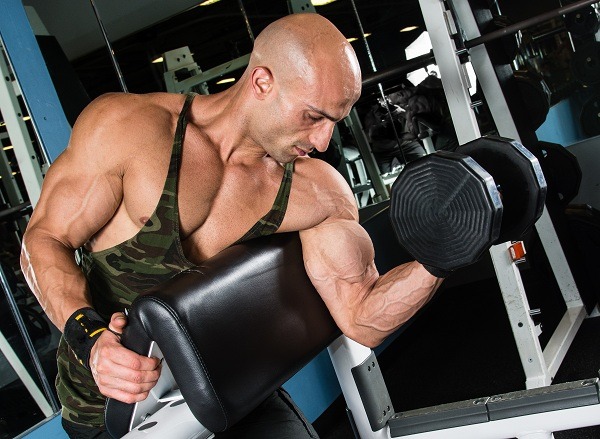
Steps:
- Look for the preacher curl bench on your gym. This is the one where the seat is behind an inclined surface. Set the level of seat according to your height and where you are most comfortable.
- On the inclined pad in front of you, rest your arms and elbows over it. The arm triceps should be at the top of the pad and your elbows in the middle. Make sure to follow this form to avoid arm injuries.
- As you are holding one dumbbell in each hand, raise both in a motion going to your chest. Pause for a moment when you reach the peak. The motion should be in a form of an arc.
- Here is the most important part; Remember to be gradual and smooth when letting go of the dumbbells as you return to the starting position. This causes a lot of injuries for people who just instantly let the dumbbells just carry their arms downward.
Benefits:
- Great Bicep Workout.
- Forearms are also involved in muscle build-up
#3 Concentration Curls
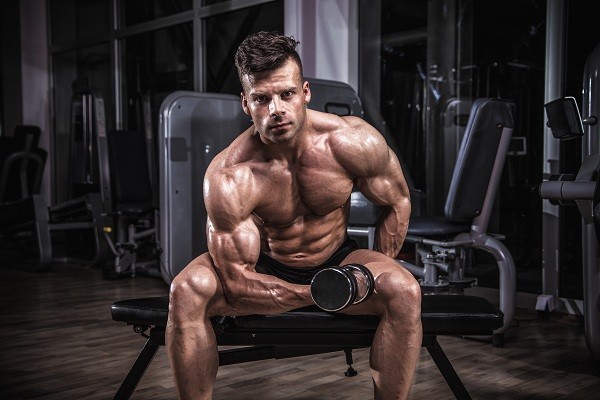
Steps:
- Sit on an edge of a bench or any seat. Feet should be flat on the floor
- Place your elbow on the inside part of your thigh, just above your knee
- In this exercise, remember that your elbows will be the foundation of all your movement and it should not be moving around as it can cause injuries to your joints.
- Start as your hold one dumbbell on hand and do a curl raise that is approaching your face.
- Do not use momentum/swinging back in raising the dumbbell. Your motion should start at the bottom part.
- Slowly lower the weight after you reach the peak of the curl.
Benefits:
- Full arm and Bicep Workout
#4 Triceps Kickbacks
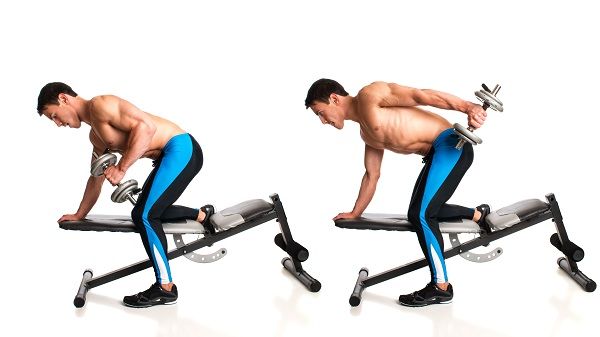
Steps:
- On a flat bench, place one arm and leg. Your form will appear as one half of your body is on the bench and the other half is stepping on the ground.
- Hold a dumbbell on the side in which your body is stepping on the ground.
- Raise your elbow and make sure your upper arm is parallel to the ground. Only your lower arm will be moving in this exercise.
- As your elbow is bent in right angle form, raise the dumbbell in a backward motion. You will feel the triceps being affected by the motion. Remember, only your lower arm is moving.
- Slowly return the dumbbell to starting position
Benefits:
- Concentrated Triceps Workout
#5 Half Squats
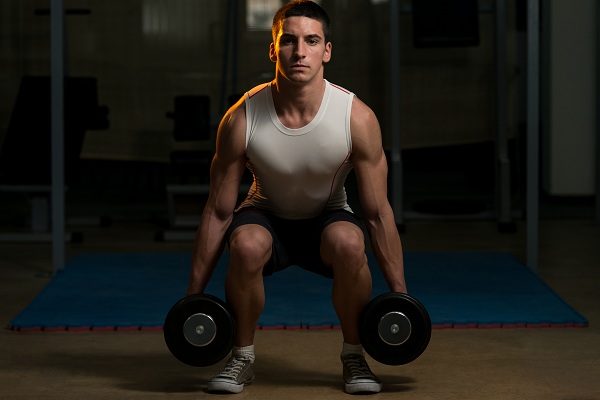
Steps:
- Hold Dumbbells at the side of your hips as you are standing straight. Your feet should be shoulder apart.
- Bending motion will start at your knees. The thighs will be moving downwards and you will know the peak of your motion when your thighs appear to be parallel to the floor.
- Keep your back flat and the lower back slightly arched inwards. Head must always be facing in front during the exercise.
- Return to the starting position using your knees and thighs only. No other movements coming from your body.
Benefits:
- Leg Workout
- Lower Back Workout
#6 Dumbbell Bench Press
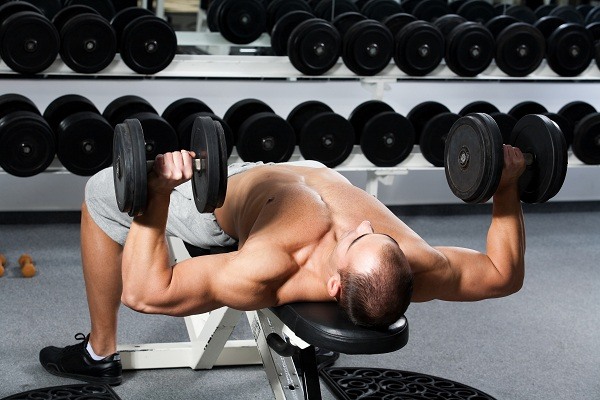
Steps:
- This is one of the easiest chest workouts with dumbbells yet the most effective one. What is important is that you achieve the proper form.
- Start by lying on a flat bench and hold a pair of dumbbells, one per hand.
- Hold the Dumbbells upward and raise them one by one on your shoulder width to know if you can withstand the weight of each one per hand.
- The shoulder level raise will be your starting position. The Dumbbells should be at the side of your chest. Your forearms should create a 90-degree angle.
- Raise the Dumbbell upwards, maintaining your form. Exhale as you execute this motion
- When you reach the peak of your motion, pause for a moment then gradually lower the Dumbbells again until your reach the shoulder level (your starting position)
- Remember to inhale before lifting then exhale when pushing the Dumbbells upward
Benefits:
- Chest workout
- Triceps workout
Conclusion
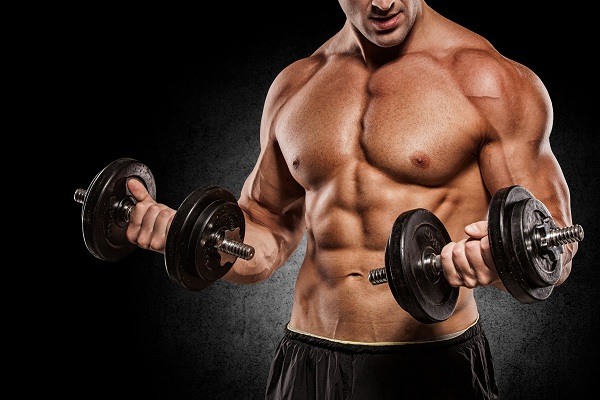
With all these forms, you can create a Dumbbell workout routine of your own. I hope my tutorial has helped you learn the basics of Dumbbell workout and that you can apply this on your daily gym routines. I hope you have enjoyed reading and would love to hear your comments and suggestions. Kindly write them below and I will try to answer the best way I can.
Thanks again for reading!
References
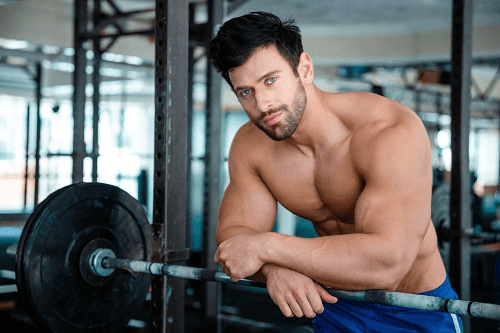
Hi there,
I’m Gregory Brown, chief editor at ConstructMuscles.com
I spend half of my time in this blog while the other half on being physical fitness trainer. Believing in the great benefits of bodybuilding and fitness to the body, I’ve been motivated to become a fitness enthusiast. It also was what gave me the self-confidence and assurance within myself both physically and psychologically.
